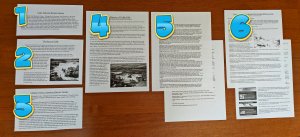Rolling Text Sets Make Content Accessible for All Students
Teachers can encourage critical thinking by giving students reading assignments that build their knowledge gradually.
Your content has been saved!
Go to My Saved Content.As teachers, our goal is to see every student succeed. Students enter our classrooms with a wide range of reading skills, and it’s our responsibility to use teaching methods that meet their needs. I’ve found a strategy called rolling text sets to be very effective for all of my middle school students—and particularly those who may need extra reading support.
Rolling text sets allow students to build deep knowledge while keeping the cognitive load manageable for them. Many readers who do not feel confident in vocabulary and background knowledge are intimidated by long, complex texts. Mary Ann Cappiello, a professor of language and literacy, explains that text sets make “texts at higher reading levels more accessible for all students” because they intentionally build student vocabulary and background knowledge before introducing students to more complex texts that stretch students to think critically about a topic.
Develop Comprehension and Vocabulary Incrementally
Rolling text sets are a short series of articles that allow students to build content knowledge and vocabulary in a way that is very attainable. Essentially, a rolling text set contains five to 10 articles that are taught during a one-to-two-week unit and that sequentially increase in length and complexity. The articles in the beginning of a rolling text set are very short. Cappiello says that “shorter texts have the greatest potential for building prior knowledge on a topic so that students can later tackle longer, more complex texts.” At the end of a text set, students are reading very complex, high-level articles.
Text sets can be adapted to fit any grade level or for any topic. Here is an example of a rolling text set I use with my sixth-grade social studies students.

Start Small to Maintain Knowledge Retention
In class, we study Oregon tribes. During this unit, we explore tribal sovereignty, treaties, and Celilo Falls. The first text I give students is a one-paragraph piece that I wrote to introduce the big ideas to be studied, as well as the vocabulary. The reading is purposefully short. Studies show that students’ retention of knowledge and ability to transfer the knowledge into long-term memory is greater when students read short passages. When I gave this short reading to one of my students who typically has difficulty with complex texts, he looked at me, confused, and said, “That’s it? This is easy!”
While that student was encouraged and felt successful, my students with advanced reading skills were engaged because they were learning new complex vocabulary. In a formative assessment the day after we read the short article, 94 percent of my students were able to define tribal sovereignty and treaties accurately.
On the second and third days of the unit, I provide students with a half-page article about Celilo Falls and a half-page article about tribal sovereignty and treaties, both written by me. These articles were written with the intention of reinforcing the big ideas about Celilo Falls, reusing the vocabulary that students learned the previous day, introducing more vocabulary, and beginning the critical-thinking process.
Provide Challenging Material to Encourage Deeper Thinking
After reading the articles and completing short activities based on the content, my students began making deeper connections on the subject.
Examples of activities that I have students complete after reading an article include:
- Discussing the article with peers, writing a 140-character “tweet” with the main idea of the article,
- Drawing the most important thing they learned from the article (quick, less than five minutes),
- Working with peers to create an idea web displaying the most important information from the article,
- Writing lists of questions they are still wondering about after reading the article,
- Creating their own sentences using the vocabulary words from the article and sharing their sentences with a partner, and
- Developing their own questions based on the article and quizzing a classmate.
On the fourth day, they read a full-page article about tribal sovereignty and its connection to Celilo Falls, and my students were able to have insightful conversations using information from the texts. The next day, I gave them a longer, challenging two-page article from the Oregon Historical Society about the history of Celilo. On the following day, they read a challenging high-level text by Oregon Public Broadcasting about fishing rights and legal cases surrounding tribal law.
Although the two longer texts are far above a sixth-grade reading level, all of my students were able to make phenomenal connections and use very high-level critical-thinking skills as they debated some of these challenging topics.
I rarely give students more than one article in a day. In this unit, I give only one article a day because these concepts are complex and students need time to process the information and interact with it. If the time is not given for processing and interacting with the material, the learning is not meaningful for students.
The greatest thing about using rolling text sets is that they systematically prepare all students to use high-level critical thinking when they read complex articles and encourage growth in their vocabulary knowledge. With the support of rolling text sets, my students who read below grade level are able to fully grasp the concepts presented in the complex articles as a result of the slow, rolling introduction and the scaffolded lead-in to complex articles, and they have made great gains on their summative assessment scores.
